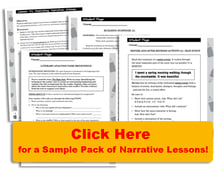Narrative writing…you’ve heard the term, you’re expected to teach your students how to write a narrative story or personal experience narrative, and you’re given rubrics that describe and define what the state sees as effective examples of the successful narrative.
But what is narrative writing? What are the salient characteristics of a successful narrative? What about author’s purpose and audience? Character/problem solution vs personal experience? What specific skills must the author possess? And, beyond all this, the big question is, why is it important to teach narrative writing at all?
WHAT IS NARRATIVE WRITING?
At its core, narrative writing is the art of telling a story. It involves constructing a tale that centers around a main character in a particular setting who faces a challenge, goes on an adventure, or experiences something significant. What happens to the main character is called the plot. The plot follows a clear structure.
- Beginning: Introduces the characters, setting, and the initial problem or scenario.
- Middle/MAIN EVENT: This is the most significant part, where the bulk of the action or experience occurs. It involves a problem to be solved or a significant life experience for the main character.
- End: The conclusion, where the problem is resolved or the significant event comes to a close.
AUTHOR’S PURPOSE AND AUDIENCE:
The primary purpose of narrative writing is to entertain. However, the specific purpose can vary—authors might aim to convey a lesson, share a personal experience, or engage the audience emotionally. A key aspect of this genre is understanding who the intended audience is. Writers need to consider how their story will connect with readers, ensuring it is engaging and relevant to them.
TYPES of NARRATIVE WRITING:
There are many variations or subgenres under the umbrella of “narrative writing.” Folk tales, fairy tales, fables, tall tales, realistic fiction, fantasy, memoirs – to name just a few. While all of these are characterized by particular unique characteristics and patterns, they all can be grouped under broader categories that are helpful to us in preparing and empowering young readers and young authors.There are two main types of narratives:
- Character/Problem-Solution Narratives: This is indeed one of the most popular types of storytelling and is often the structure young authors gravitate toward, largely because it’s familiar. They’ve encountered it countless times in books, movies, and TV shows, and it follows a clear, understandable pattern: a problem arises, the protagonist faces it, and by the end, the hero either overcomes the obstacle or learns something valuable from the experience. This type can be fictional or based on real events. The main focus is on how the character navigates challenges and resolves issues.
For young writers, this is a fantastic entry point exploring the themes of growth and change. The main character is often tested in various ways, but in the end, emerges transformed. This narrative type becomes a great tool for making predictions. When students understand the basic pattern of this genre, they can better anticipate how stories might unfold, which both deepens their comprehension and enhances their creative writing skills.
Check out some excellent CPS books - Brave Irene by William Steig, Jabari Jumps by Gaia Cornwall and Oliver Button is a Sissy by Tomie dePaola.
- Personal Experience Narratives: These stories focus on significant life moments or experiences rather than a problem or challenge. These stories aren’t about conflict or resolution, but about reflection, emotion, and meaning. Writing this kind of narrative often demands a higher level of craft, bringing the reader into the story world through the use of advanced language/vocabulary. Sensory detail is key to bringing the reader into the scene, making them feel what the character feels and see what they see. In order for young readers to tap into their own imaginations, it is important to point out that the writer does not have to own the experience, but the author has creative liberties to expand the character using their own curiosities.
Some great examples for children in the PE category include Owl Moon by Jane Yolen, Paperboy by Dav Pilkey, and Namaste is a Greeting by Suma Subramaniam.
By teaching narrative writing, students not only learn the fundamentals of storytelling but also develop crucial life skills such as reflection, empathy, and effective communication. Narrative writing is not just about telling stories—it's about teaching students to express themselves and make sense of the world around them.
For more information about the skills students need to know to write a narrative story, check out Key Skills to teach Narrative Writing.
Check us out!
Our resources like the Empowering Writers’ Narrative Guide, or the All-in-One Guide take you on a deeper dive into the skills of narrative writing. These guides offer structured tools, strategies, and examples that make it easier to teach and learn the nuances of clear, effective writing. They help break down the steps of narrative stories into manageable pieces, such as how to write and entertaining beginning, crafting a well-developed Main Event, and concluding the story with an extended ending.
And the dynamic workshops are an awesome way to reinforce these skills, allowing for hands-on learning and real-time feedback. Have you had the chance to explore any of these resources or workshops yet? They are a great fit for anyone looking to improve their writing expertise!
Plus, review our sample packs of narrative lessons:
